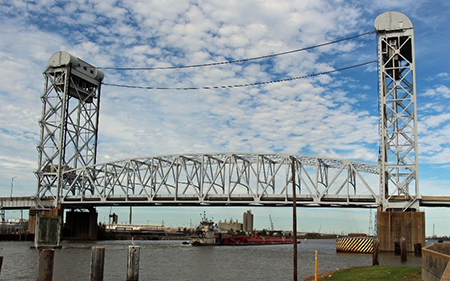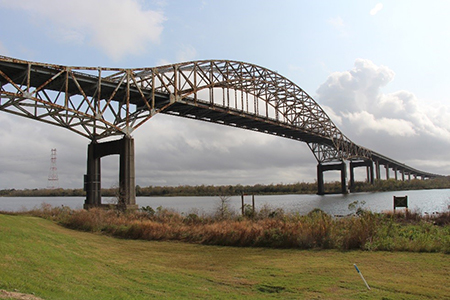
Louisiana Historic Bridge Effort Increases Preservation Opportunities
and Expands Agency Partnerships
Louisiana has a long and rich history of innovative bridge building. Often necessitated by the State’s unique wetlands and water-based topography, Louisiana bridges encompass many different technological, engineering, and design features. To preserve these special bridges, the Louisiana Department of Transportation and Development (LADOTD) set out to develop and implement a historic bridge inventory project to identify historically significant bridges built prior to 1971 and create a plan to preserve and manage them, when possible.
What Qualifies a Bridge
as Historically Significant?
According to the Advisory Council on Historic Preservation (ACHP), properties considered eligible for listing on the National Register of Historic Places (NRHP) are evaluated based on whether or not the quality of significance in American history, architecture, archeology, engineering, and culture, is present. They are additionally evaluated on whether or not they possess integrity of location, design, setting, materials, workmanship, feeling, and association with events or the lives of persons significant in the past. ACHP also considers whether or not they embody distinctive artistic characteristics, or will someday yield information important in history.
Prior to this effort, LADOTD did not have a method in place to determine whether or not a bridge had historical significance and assessed bridges on a project-by-project basis. Records of an individual bridge’s engineering information are rarely available, so bridges are difficult to classify as historically significant without a common methodology. Working with the Louisiana State Historic Preservation Office (LASHPO) and the Federal Highway Administration (FHWA) Louisiana Division Office, LADOTD established a methodology for identifying historic “Preservation Priority” bridges.
From 2014 to 2015, the partners completed an inventory of Louisiana’s historic bridge population; in September 2015, they signed a Programmatic Agreement (PA) for historic bridges; and in June 2016 they completed a Statewide Management Plan to implement the agreement. These activities have helped shorten the environmental review and project delivery process for historic bridge projects from three to six months. Historic bridges are no longer processed individually for Section 106 of the National Historic Preservation Act (NHPA) (with the exception of border bridges), and bridge designers know in advance which bridges are committed for long-term preservation.
LADOTD Expands Partnerships to Efficiently Study and Inventory State Historic Bridges
Staffing shortages led LADOTD to seek support from Mead & Hunt, an engineering and architectural consulting firm with expertise in bridges and cultural resources, to inventory its historic bridge population and work with its partners to develop a PA. With assistance from Mead & Hunt, LADOTD convened its State and Federal partners and started the project in the spring of 2014 by commissioning a study of historic bridges across the State.
Using the “Methodology to Identify Preservation Priority Bridges,” which describes methods for identifying the historic bridges in Louisiana that are most suitable for preservation, LADOTD identified 150 historic bridges throughout the State that are listed in or determined eligible for listing in the NRHP.
LADOTD and its partners prioritized bridges based on historical and engineering factors to focus future LADOTD preservation efforts on the State’s most significant historic bridges. Engineering considerations included the potential for rehabilitation, whether or not the geometrics were satisfactory, whether or not the bridge was within acceptable live load capacity i.e., the weight of vehicles, people, and goods, and if there was acceptable detour distance for restricted bridges. To share these results with the public and other interested stakeholders, LADOTD launched a historic bridge inventory website and compiled a summary of rehabilitation projects identified using the inventory. To ensure FHWA will meet its Section 106 responsibilities, LADOTD and FHWA developed and implemented the PA.
PA Makes Agency Roles in Historic Bridge Preservation Clear
The PA streamlined the Section 106 process for bridges and future preservation efforts. LADOTD, LASHPO, FHWA, and the ACHP signed the agreement on September 21, 2015, and FHWA committed to the following high-level tasks:
- Developing a Statewide Management Plan for historic bridges;
- Identifying individual management plans for “Preservation Priority” bridges; and
- Developing the Historic American Engineering Record documentation for a variety of bridge types throughout the State.

The State Route 39 Inner Harbor Navigation Canal Bridge, also known as the Judge Seeber or Claiborne Avenue Bridge—built in 1957—has a steel vertical lift span. It was labeled a “Preservation Priority” bridge and was recently rehabilitated. (Courtesy of LADOTD)
The PA was executed to assist the State in efficiently working through the Section 106 process and assure the preservation of the best examples of each type of historic bridge available. In the agreement, FHWA is responsible for reviewing consultations for Section 106. LADOTD reviews and classifies historic bridges, and issues maintenance directives, alternative analysis, and design development process requirements for historic bridges outlined in the PA.
The PA serves as a guide for the State to ensure all historic bridges are evaluated using the same method. It also affirms the partners’ commitments to invest in historic bridge preservation each year and to implement the individual maintenance plans developed through the PA. The PA outlines the following activities and each agency’s corresponding responsibilities:
- Treatment of Louisiana historic bridges;
- Management plans for historic bridges;
- Stewardship, public outreach, education, and funding;
- Emergency situations for historic bridges; and
- Annual reporting.
Historic Bridge Inventory Project Accelerates Bridge Project Delivery across Louisiana
What Is Section 106?
Section 106 of the NHPA of 1966 requires Federal agencies to take into account the effects of their undertakings on historic properties, and afford ACHP a reasonable opportunity to comment.
LADOTD has dedicated staff to maintain and update the bridge inventory in accordance with the PA, and the agency’s environmental coordinator consults with cultural staff on any proposed activities not outlined or agreed to in the PA. These procedural changes helped the LADOTD environmental section identify the entire pre-1971 historic bridge population in Louisiana and it uses the PA for processing bridge projects for Section 106 review.
Bridge program staff now understand the significance of a structure; they understand what can and cannot be done with respect to the structures identified in the PA; and during project development, the bridge may enter into the Section 106 process months ahead of schedule because all information on the eligibility of the structure and the types of activities allowed is readily available. The PA also allows LADOTD to rehabilitate or replace structures that have been through the PA process, without having to enter into the individual Section 106 process to make that determination.
Additional PA Stipulations
Some historic bridges were identified as eligible for the NRHP prior to the inventory, but the PA has a stipulation to reevaluate the bridge population in 2021 and 2031.
The PA does not apply to projects that have completed separate Section 106 compliance, are State border bridges, or are pre-1971 historic bridges built and maintained solely with local funds.
Other streamlining benefits include the following:
- Only 121 (less than three percent) of the State’s 4,000 bridges are covered by the PA and subject to consideration under Section 106. An additional 29 historic bridges are subject to separate Section 106 review.
- Non-priority historic bridges are not ideal candidates for long-term use and are eligible for replacement when needed. These bridges can undergo a streamlined Section 106 process.
LADOTD established a historic bridge marketing program webpage to showcase all of the bridges available for adaptive reuse, including, for example, walking or biking trails. If a bridge cannot be preserved for its original intent, LADOTD posts it on the marketing program webpage for other entities to propose relocating or reusing. The agency has also increased public involvement on historic bridge projects through public presentations, a project website, project email notifications, and the “Crossing the Bayou: Louisiana’s Historic Bridges” report, which highlights bridge building in Louisiana and provides a guide to historic bridges that represent significant engineering designs, important trends, and historical events.
PA Includes Training and Reporting Requirements that Maintain Project Momentum
The PA requires LADOTD to develop and deliver a training on preventative maintenance, preservation, and rehabilitation of historic bridges and related processes every two years. This ensures State staff and contractors understand the requirements of the PA and emphasizes the importance of upholding the terms of the agreement.
LADOTD also convenes environmental, bridge, and maintenance staff to compile an annual report on PA implementation. The report discusses bridges reviewed or addressed that year, the results of the marketing program, recommendations for program improvement, and any scheduling changes or problems encountered while implementing the PA. The first annual report was published on September 16, 2016. Highlights from the year included:

A rehabilitation project is scheduled for the Gulf Outlet Bridge, a “Preservation Priority” bridge. (courtesy of LADOTD)
- Seven projects involving eleven historic bridges included in the PA were initiated in the reporting year (2015-2016);
- LADOTD began marketing the Boeuf River Bridge and was preparing to market the Carol Street Bridge for reuse;
- The Statewide Management Plan was finalized within 10 months of the PA execution and posted online;
- Management plans for 14 “Preservation Priority” bridges were drafted and sent out to consulting parties for review in 2015-2016;
- The 10 City Park Bridges in New Orleans, consisting of nine concrete arch bridges and one rigid frame of similar construction and date, were included in one management plan;
- Fieldwork for a second group of management plans for “Preservation Priority” bridges was conducted and draft reports produced and distributed for review; and
- LADOTD staff conducted public outreach and trainings.
The PA recognizes the importance of dedicating funding to implement the requirements set out in the document. So long as funds are available and the agreement is in place, LADOTD will dedicate funds annually to maintenance, preservation, and rehabilitation activities on LADOTD bridges. LADOTD has actually been able to dedicate funds beyond the amount it agreed to in the PA to perform rehabilitation on all categories of historic bridges.
PA Benefits Go Beyond Preserved Bridges, Improve Communications among Partners
LADOTD achieved its ultimate goal to identify historic bridges and focus preservation efforts on those that can continue to serve a transportation function, while streamlining project development for all pre-1971 historic bridges. The agency has also improved collaboration both internally among various departments and externally with other State agencies. The entire effort provided benefits for both cultural and transportation resources, balancing the need for safe transportation as well as historic preservation. The process of working together for five years on the historic bridge committee, inventory, methodology, and PA helped LADOTD improve communications with SHPO and FHWA.
Contact Information
Stacie Palmer
Environmental Impact Specialist, DCL
Louisiana Department of Transportation and Development
225-242-4517
Stacie.Palmer@la.gov
Robert Mahoney
Environmental Coordinator
Louisiana FHWA Division Office
225-757-7624
Robert.Mahoney@dot.gov
Look What’s New!
- FHWA released an updated version of the Energy and Emissions Reduction Policy Analysis Tool (EERPAT), which is an integrated, state-level modeling system designed to evaluate strategies for reducing energy consumption and surface transportation greenhouse gas emissions. This version (v3.0) has a user-friendly interface for those who are not proficient in R software language.
- The October issue of the newsletter, “FHWA
FAST
Act Guidance Accelerates Surface Transportation Project Environmental Review Processes” describes changes the FAST Act has had on various environmental subject areas. Sign up to receive updates when new FAST Act materials are available on the Environmental Review Toolkit.
- The newsletter is celebrating 15 years of successes in project streamlining and environmental stewardship! Check out our celebratory issue and learn more about the past 15 years with this infographic!
Successes in Stewardship is a Federal Highway Administration newsletter highlighting current environmental streamlining and stewardship practices from around the country. Click here to subscribe, or call (617) 494-3719 for more information.

